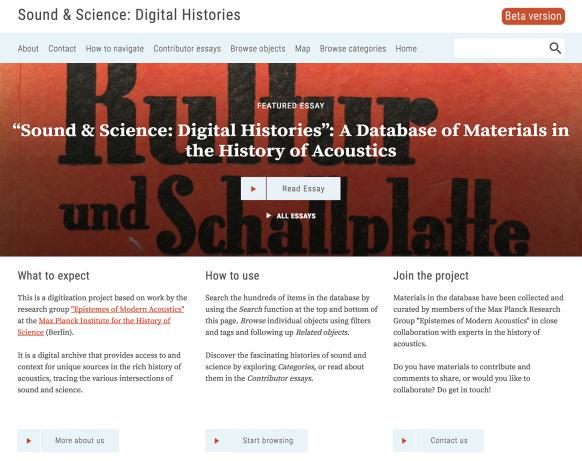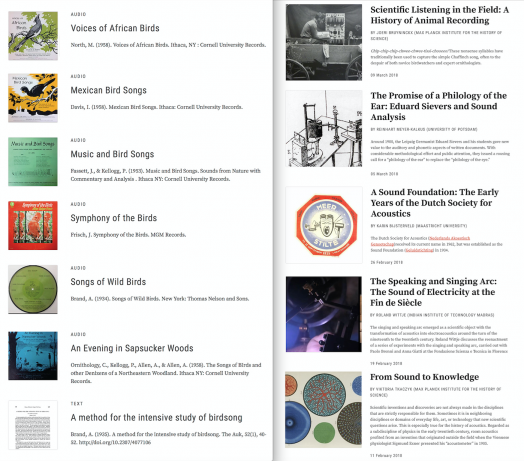Berlin saw the establishment, between 1900 and 1930, of several institutions that interacted with each other through a novel interest in acoustics. The electrical engineering company Siemens & Halske flourished, building the “Siemensstadt” settlement in Berlin’s northern district of Charlottenburg, and Carl Lindström AG, headquartered in the Kreuzberg district, developed a global market for gramophone technology. At the same time, Carl Stumpf’s Institute for Psychology, with its focus on tone psychology, expanded from its tiny university venue in Dorotheenstrasse to a large-scale research center in the Berlin City Palace. During World War I, Stumpf and the phonetician Wilhelm Doegen also founded the Royal Prussian Phonographic Commission to record the languages and music of “colonial” prisoners of war interned near Berlin. This opportunistic research initiative during the Weimar Republic eventually led to the formation of two sound archives: the Berlin Phonogram Archive and the Lautabteilung (“sound department”) of the Prussian State Library. Later, during the 1920s, Berlin also witnessed the creation of an experimental radio laboratory—the Rundfunkversuchsstelle—at the Academy of Music, supervised by an advisory board with representatives of the Imperial Post Department, the Heinrich Hertz Institute for Research on Oscillation, and the two Berlin radio stations Deutsche Welle and Berliner Funk-Stunde. Bound by politics, industry, science, art, and technology as these endeavors all were, they facilitated the formation of long-lived infrastructures, technological heritage, and entire research fields—including electroacoustics, experimental phonetics, linguistics, phoniatrics, language studies, musicology, radio studies, bioacoustics, and tone psychology.

Fig. 1: Object “Versuchswalze,” from the curated collection “Carl Stumpf’s experimental records.”
The Max Planck Institute for the History of Science’s new sound database “Sound & Science: Digital Histories”—the fruit of archival research and conceptual work by the Max Planck Research Group “Epistemes of Modern Acoustics”—aims at disentangling these complex institutional networks. Research projects within the group trace the genealogy of acoustic knowledge throughout the modern era, charting the making of the discipline of acoustics and exploring the historical conditions that allowed acoustic knowledge to be turned into scientific knowledge—and back into the practices of musicians, architects, engineers, or everyday listeners. They unpick sonic strategies of knowledge production in various scientific and humanistic disciplines, strategies—sometimes manifest, but often implicit—that have previously been largely overlooked by historians of science.

Fig. 2: Home page of the newly launched database “Sound & Science: Digital Histories.”
Connected to these research themes, the “Sound & Science” database, currently in its beta version, provides valuable access to a diverse range of sources in the history of acoustics—many of them previously unavailable in digital format. The resource includes a multimedia archive of primary source material, documentation of surviving technology, and historical reenactments of crucial experiments in acoustics. Visualization tools open up large-scale and longue durée views on the history of sound and science, allowing users to explore and assemble material in unprecedented ways. The database includes sound files, texts, and images, which can be browsed using a full-text search function or via curated collections, or can be viewed on a map. Examples include curated collections “Carl Stumpf’s experimental records” or the “Cornell University Laboratory of Ornithology’s Recordings of Birdsongs.” Go to the map, focus on “Berlin,” narrow the slider to “1900–1930,” and you will find primary sources on the local network of institutions described above.

Fig. 3: Map showing a search result.
Additional analysis tools of the database reflect the variety of people, places, scientific disciplines, practical fields, technologies, building materials, and theoretical topics that have shaped acoustic history. Its tagging system connects all holdings that—for example—mention technologies such as “tuning forks” or “sirens,” materials such as “metal” or “wood,” or topics like “speech/voice” or “noise.” These instruments, all equipped with short explanatory textboxes, are anticipated to turn the database into a research tool in its own right, aiding scholars in the identification of new connections and sites of inquiry.

Fig. 4: Right: Collection of contributor essays. Left: Collection of material related to the keyword “Bird Song.”
By bringing together archives from a great variety of places and periods—from Ancient Greece and Rome to contemporary Taiwan—the “Sound & Science” database offers users a means to recover the historical multiplicity of scientific, artistic, religious, and political practices entwined with the study of sound. The collection is continually extended through the efforts of members, guest scholars, and collaborators of the Research Group, thus serving as a record of its collective project. To source, digitize, and contextualize rare material, the database team works with international partners including the Deutsches Museum in Munich (Research Group “Materiality of Musical Instruments”), the Science Museum in London, New York University, the University of Cambridge, Maastricht University, the University of Amsterdam, and the Humboldt University in Berlin.
Collaborators of the database project assist in linking and contextualizing historical sources through specially-curated exhibits and a series of accessible multimedia essays. Written by outstanding experts in musicology, sound studies, and the history of science, technology, engineering, and architecture, the essays frame the objects in light of the disciplines’ latest insights (read our initial collection of contributor essays, and consider adding one yourself!). In turn, database objects can be directly linked to users’ own digital and print publications using QR codes and shortened URLs.
The database has been developed in cooperation with the Research IT group of the MPIWG. It took further inspiration from earlier projects of the institute such as the “Virtual Laboratory,” and from existing digital humanities projects in the history of science and sound studies. Among these are jewels such as a reconstruction of New York’s “Roaring Twenties,” an interactive map of the phonograph stores in Paris, an historical collection of Phono-Post recordings worldwide, and the British Library’s various projects to catalog, map, annotate, and analyze historical sound recordings. The database complements these highly-focused digital platforms by opening up a broad-based notion of the history of acoustics and its sources. Rather than aspiring to being comprehensive in any respect, it provides the opportunity for rich cross-referencing that reveals striking and unexpected historical relationships between the sources. The database currently contains around 1,000 items, but this is its very first step: content continues to be added, and the features and functionality of the site refined. The Research Group looks to expand and explore new ways of responding to the specific challenges raised by digital histories of sound. Contributions, feedback, and suggestions in further developing the beta version are welcomed. Join us in celebrating the launch of what we hope will be a growing and dynamic scholarly resource for research in the history of acoustics!
